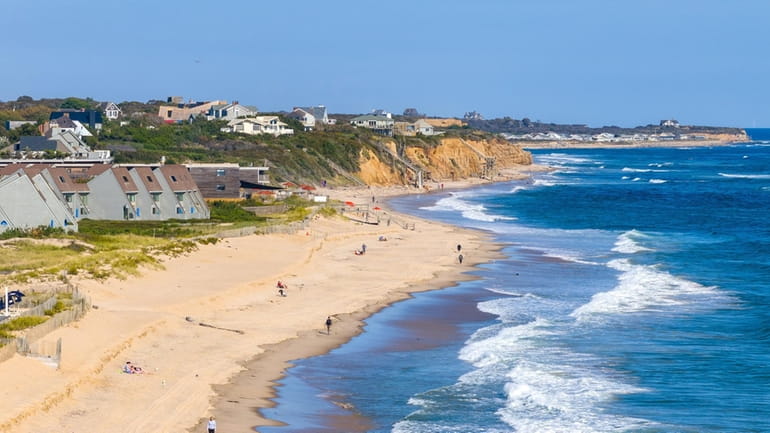Suffolk hotel tax revenue, up 53%, to fund tourism promotion, convention center

A view looking east from Kirk Park Beach in Montauk on Oct. 12, 2023. The Montauk ZIP code generated more than $4.6 million in hotel-motel tax revenue last year, the most of any other areas in Suffolk County. Credit: Newsday/J. Conrad Williams Jr.
Revenue from a tax on hotel stays in Suffolk County — money that is used to promote the region as a tourism destination — increased by 53% after the county nearly doubled the tax last year.
Collections from the 5.5% per-night tax on hotel stays and homeshare rentals brought in $21,555,345 in 2023, up from $14,088,391 the previous year, when the tax was 3%.
The Suffolk County Legislature approved raising the tax last April, largely to increase the amount of money given to a regional tourism agency and to provide a stable revenue source for a planned convention center that would be Long Island's first. The tax increase, signed by former County Executive Steve Bellone, went into effect in June and is levied in addition to Suffolk’s 8.623% sales tax.
The Montauk ZIP code brought in the most hotel-motel tax revenue: $4,653,241 in 2023, up from $3,503,701 the previous year.
While most of the revenue comes from the East End, where the highest-priced hotels are located, other top ZIP codes include Melville, with $1,177,323, up from $859,241 in 2022; and Hauppauge, with $1,047,835, up from $642,184.
Here’s how the additional funds will be used:
The county has raised the amount of annual funds it provides to the nonprofit tourism promotion group Discover Long Island from $2 million to $6 million. The additional funds allowed the organization, whose entire annual revenue was $3.5 million in 2022, to expand its marketing and hire more support staff, according to executive director Kristen Reynolds.
“We have been grossly underfunded for decades,” Reynolds said. “And so we have a lot of catching up to do.”
The organization plans to add marketing in cities like Philadelphia, Washington, D.C., Boston and potentially in “long-haul” markets like Atlanta.
“The goal is always to have the visitors that are going to stay longer and spend more money as opposed to day-trippers and people that come and have more of a burden on your infrastructure or your quality of life," she said.
Of the revenue collected, $17,250,000 is committed to various agencies and regions, including the $6 million to Discover Long Island, $3.25 million to Suffolk parks and $1.25 million to the Vanderbilt Museum, Mansion and Planetarium in Centerport. The remaining money is allotted for the recently created Suffolk County Infrastructure Fund, which will be used to build a convention center in Ronkonkoma, part of a $2.8 billion redevelopment project known as Midway Crossing.
“It is a way for Long Island to get into the association and convention business, which we've never been able to before, while other much smaller communities like Syracuse and Albany and Hartford and Buffalo have convention centers and attract a sizable amount of business,” said Mitch Pally, chairman of the Midway Crossing project’s nonprofit local development corporation board and chairman of the board of Discover Long Island.
The convention center is expected to cost about $300 million, and the tax revenue will fund construction bond payments, Pally said. Officials are hoping construction will begin in 2025, he said.
A December study from global consulting firm HVS, commissioned by the county and Discover Long Island, estimates the convention center could generate $88.6 million in annual economic impact.
Heywood Sanders, a professor at the University of Texas at San Antonio who has studied convention centers for 25 years, said consultants often overestimate their economic benefit. He noted the HVS study estimated that 150,000 of the 259,000 annual attendees would be for consumer shows, which often do not attract out-of-town visitors.
“It doesn't necessarily play out the way folks say it will,” Sanders said. “It is not uncommon for convention centers to do, in terms of hotel room nights or convention attendance, less than half of the business that consultants forecast.”
Suffolk last year began contracting with international government software provider Granicus to find people who rent homes on Airbnb and other websites and notify them of the tax, which also applies to vacation home rentals. The software uses A.I. technology and employees to determine which properties are available for rent and notifies the property owner that they must pay the tax.
As a result, Suffolk County Comptroller John Kennedy said the number of owners paying the tax has increased from 2,400 to about 3,400.
Kennedy, who said his office does not have the staff to find vacation home rentals and enforce payment of the tax, said there may be less expensive solutions than Granicus' $269,000 annual fee for the service.
Granicus representatives did not immediately respond to a request for comment.
Revenue from a tax on hotel stays in Suffolk County — money that is used to promote the region as a tourism destination — increased by 53% after the county nearly doubled the tax last year.
Collections from the 5.5% per-night tax on hotel stays and homeshare rentals brought in $21,555,345 in 2023, up from $14,088,391 the previous year, when the tax was 3%.
The Suffolk County Legislature approved raising the tax last April, largely to increase the amount of money given to a regional tourism agency and to provide a stable revenue source for a planned convention center that would be Long Island's first. The tax increase, signed by former County Executive Steve Bellone, went into effect in June and is levied in addition to Suffolk’s 8.623% sales tax.
The Montauk ZIP code brought in the most hotel-motel tax revenue: $4,653,241 in 2023, up from $3,503,701 the previous year.
WHAT TO KNOW
- Revenue from a tax on hotel stays in Suffolk County increased by 53% after the county raised the tax from 3% per night to 5.5% last year.
- The county has used the revenue to increase the amount of annual funds it provides to the tourism promotion group Discover Long Island from $2 million to $6 million.
- The rest of the revenue will go to county parks, museums, airports, historical sites and a planned convention center in Ronkonkoma.
While most of the revenue comes from the East End, where the highest-priced hotels are located, other top ZIP codes include Melville, with $1,177,323, up from $859,241 in 2022; and Hauppauge, with $1,047,835, up from $642,184.
Here’s how the additional funds will be used:
Tourism promotion
The county has raised the amount of annual funds it provides to the nonprofit tourism promotion group Discover Long Island from $2 million to $6 million. The additional funds allowed the organization, whose entire annual revenue was $3.5 million in 2022, to expand its marketing and hire more support staff, according to executive director Kristen Reynolds.
“We have been grossly underfunded for decades,” Reynolds said. “And so we have a lot of catching up to do.”
The organization plans to add marketing in cities like Philadelphia, Washington, D.C., Boston and potentially in “long-haul” markets like Atlanta.
“The goal is always to have the visitors that are going to stay longer and spend more money as opposed to day-trippers and people that come and have more of a burden on your infrastructure or your quality of life," she said.
Convention center
Of the revenue collected, $17,250,000 is committed to various agencies and regions, including the $6 million to Discover Long Island, $3.25 million to Suffolk parks and $1.25 million to the Vanderbilt Museum, Mansion and Planetarium in Centerport. The remaining money is allotted for the recently created Suffolk County Infrastructure Fund, which will be used to build a convention center in Ronkonkoma, part of a $2.8 billion redevelopment project known as Midway Crossing.
“It is a way for Long Island to get into the association and convention business, which we've never been able to before, while other much smaller communities like Syracuse and Albany and Hartford and Buffalo have convention centers and attract a sizable amount of business,” said Mitch Pally, chairman of the Midway Crossing project’s nonprofit local development corporation board and chairman of the board of Discover Long Island.
The convention center is expected to cost about $300 million, and the tax revenue will fund construction bond payments, Pally said. Officials are hoping construction will begin in 2025, he said.
A December study from global consulting firm HVS, commissioned by the county and Discover Long Island, estimates the convention center could generate $88.6 million in annual economic impact.
Heywood Sanders, a professor at the University of Texas at San Antonio who has studied convention centers for 25 years, said consultants often overestimate their economic benefit. He noted the HVS study estimated that 150,000 of the 259,000 annual attendees would be for consumer shows, which often do not attract out-of-town visitors.
“It doesn't necessarily play out the way folks say it will,” Sanders said. “It is not uncommon for convention centers to do, in terms of hotel room nights or convention attendance, less than half of the business that consultants forecast.”
More houseshare rentals paying
Suffolk last year began contracting with international government software provider Granicus to find people who rent homes on Airbnb and other websites and notify them of the tax, which also applies to vacation home rentals. The software uses A.I. technology and employees to determine which properties are available for rent and notifies the property owner that they must pay the tax.
As a result, Suffolk County Comptroller John Kennedy said the number of owners paying the tax has increased from 2,400 to about 3,400.
Kennedy, who said his office does not have the staff to find vacation home rentals and enforce payment of the tax, said there may be less expensive solutions than Granicus' $269,000 annual fee for the service.
Granicus representatives did not immediately respond to a request for comment.
Tax revenue beneficiaries
- $6 million per year to a not-for-profit tourism promotion agency
- Cultural institutions in Brookhaven, Smithtown, Islip, Huntington and Babylon will receive $1 million. Institutions in the five East End towns of Riverhead, Shelter Island, Southold, Southampton and East Hampton will receive $1 million
- $250,000 goes to cultural grant programs administered by the Suffolk County Department of Economic Development and Planning
- $1.25 million per year for the Suffolk County Vanderbilt Museum, Mansion and Planetarium in Centerport
- $250,000 per year for the Walt Whitman Birthplace State Historic Site and Interpretive Center in Huntington Station
- $1 million for other museums and historical societies, residences and birthplaces
- $250,000 to promote filming in Suffolk County
- $2.5 million per year to maintain historic sites
- $3.25 million for Suffolk County parks
- $250,000 for a Long Island regional airport and $250,000 for an East End tourism agency
- Remaining revenue is put in the Suffolk County Infrastructure Fund which benefits the convention center

